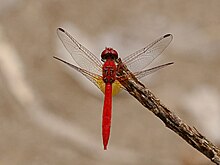Diplacodes haematodes, the scarlet percher, is a species of dragonfly in the family Libellulidae.[3] It occurs throughout Australia (except Tasmania), Timor, New Guinea, Vanuatu, and New Caledonia.[4] It is locally common in habitats with hot sunny exposed sites at or near rivers, streams, ponds, and lakes. It often prefers to settle on hot rocks rather than twigs or leaves, and is quite wary. This is a spectacular species of dragonfly, although small in size (wingspan 60mm, length 35mm). The male is brilliant red, the female yellow-ochre. Females have yellow infuscation suffusing the outer wings, while the males have similar colour at the bases of the wings.[5]
| Scarlet percher | |
|---|---|

| |
| Male | |

| |
| Female | |
| Scientific classification | |
| Domain: | Eukaryota |
| Kingdom: | Animalia |
| Phylum: | Arthropoda |
| Class: | Insecta |
| Order: | Odonata |
| Infraorder: | Anisoptera |
| Family: | Libellulidae |
| Genus: | Diplacodes |
| Species: | D. haematodes
|
| Binomial name | |
| Diplacodes haematodes (Burmeister, 1839)[2]
| |

| |
Gallery
edit-
Male and female mating
-
Red
-
Mature female
-
Female, face-on
-
Male wings have colour near their base
-
Male
-
Immature male before turning red
-
Female, highlighting brownish wingtips
-
Male, highlighting wing venation
-
Diagram of male wings
-
Photo of female wings
References
editWikimedia Commons has media related to Diplacodes haematodes.
- ^ Dow, R.A. (2017). "Diplacodes haematodes". IUCN Red List of Threatened Species. 2017: e.T83357088A83383210. doi:10.2305/IUCN.UK.2017-1.RLTS.T83357088A83383210.en. Retrieved 20 November 2021.
- ^ Burmeister, Hermann (1839). Handbuch der Entomologie (in Latin and German). Vol. 2. Berlin: T.C.F. Enslin. pp. 805–862 [849] – via Biodiversity Heritage Library.
- ^ "Species Diplacodes haematodes (Burmeister , 1839)". Australian Faunal Directory. Australian Biological Resources Study. 2012. Retrieved 1 March 2017.
- ^ Theischinger, Gunther; Hawking, John (2006). The Complete Field Guide to Dragonflies of Australia. Collingwood Vic.: CSIRO. p. 276. ISBN 0643090738.
- ^ McCoy, Michael (2010). Reef and rainforest. Collingwood, Vic.: CSIRO Publishing. p. 148. ISBN 978-0-643-09695-0.
